Posts posted by XZoro
-
-
DH2, More better than DH1.
-
Spoiler
Only project leaders are allowed to post your songs !.
Battle Cancelled.
-
Good activity in the projects and ts3, Respectful + hardworking person, deserve a chance.

-
 1
1
-
-
Spoiler
-
 1
1
-
-
Spoiler
-
 1
1
-
-
Spoiler
-
 1
1
-
-
Game Informations.
Developers : Alterego Games.Publishers : StickyLock Studios.
Released : 23 Mar, 2021.
Genre : Action Adventure, Survival.Mode : Single-player.
Platforms : Microsoft Windows - Linux - PS5 - PS4 - Xbox One - Xbox Series X/S.

Every now and again a narrative-focused horror game comes out that defies expectations, delivering scares, interesting mechanics, and a compelling narrative. Sanity of Morris is decidedly the exact opposite of that hypothetical game. From its slavish devotion to tired alien tropes, to its slow, laughable stealth sections, the game would feel right at home with the silhouettes of a guy and two robots plastered at the bottom of the screen. It’s not the worst thing you’ll ever play, but anyone actually looking for scares or competency will want to take a turn onto the next exit ramp.
The titular character in Sanity of Morris is Johnathan Morris. He’s been called to the unassuming town that his father Hank attempted to move himself and his mother to years prior to the game’s events. This attempt to move destroyed the family and changed the trajectory of their lives. The game doesn’t remotely attempt to make a compelling case as to why Johnathan would drop what he’s doing and go see Hank just because he was asked. But there wouldn’t be a story otherwise, so that’s what he does. Upon arriving at his father’s home, he discovers that the place is crawling with soldiers. Something has gone horribly wrong.
Johnathan searches Hank’s house to find an arbitrary code that grants him access to the attic. Suddenly, he finds himself drawn into a ludicrous conspiracy involving the government, an alien spaceship, and your dwindling patience. The story in Sanity of Morris is painfully generic, while the game is visually bland and lifeless. That doesn’t stop it from being heavily demanding resource-wise, as it made my GPU fans whirl harder than when running Red Redemption Dead 2.
To be fair, the game is funny, just never intentionally. Johnathan will often find voice recordings where Hank leaves him breadcrumbs. However, Hank’s voice actor sounds like he’s in a totally different game. He comes across like a cartoon character, and the dialogue and writing in the many documents scattered around only make things worse.
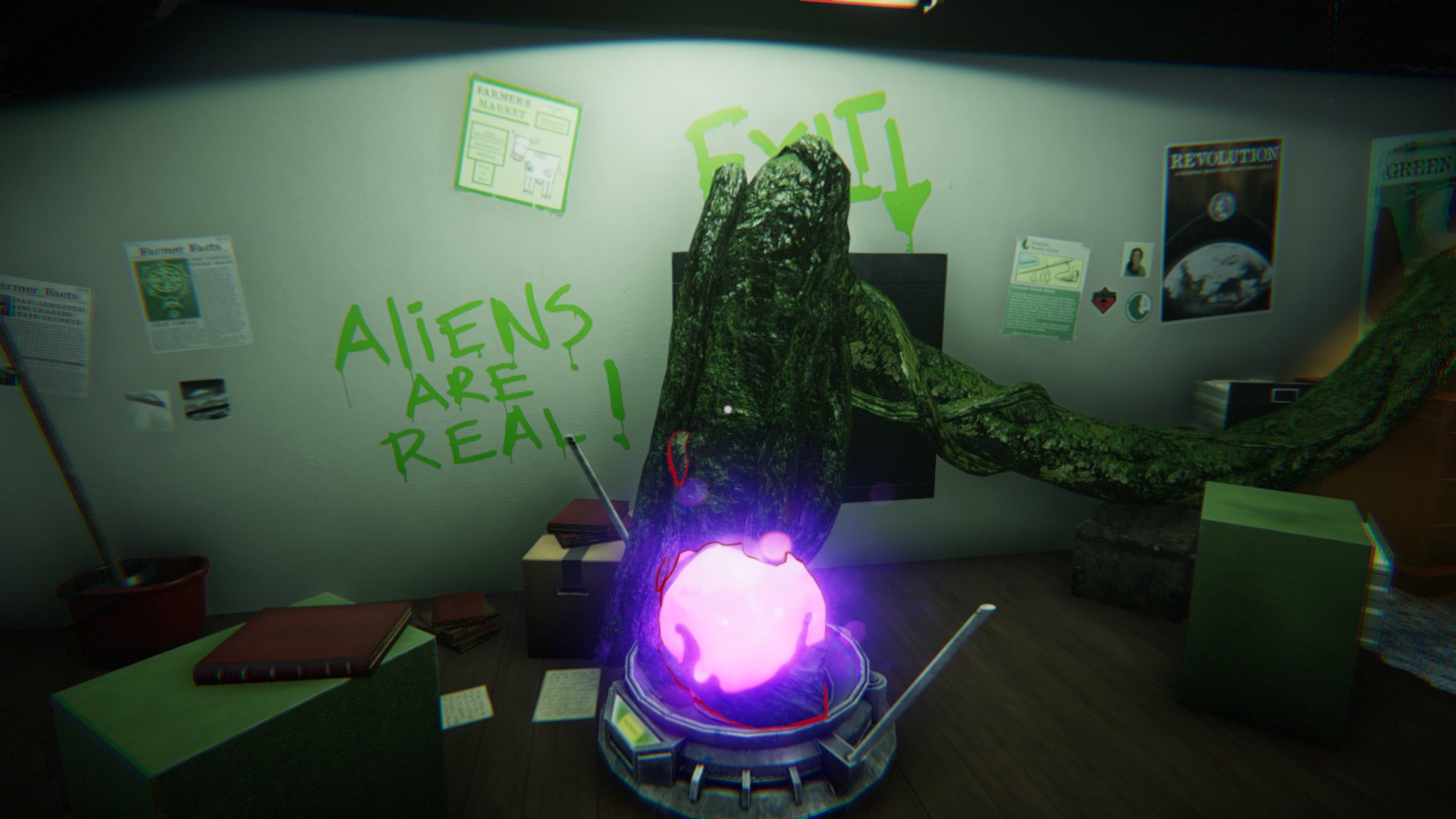
Be afraid. . . of having to play more
The story is bad? That’s hardly a deal-breaker. What about the other stuff? Well, lemme tell you about the other stuff — it’s worse. Sanity of Morris bills itself as a horror game, but it’s not scary. It’s never even creepy or tense. I’m not sure why “sanity” is in the title, as there isn’t much of a focus on Johnathan’s mental state. This is an adventure game with stealth sequences. There are three levels where you lead Johnathan through linear areas to make it to the next. Sometimes there are hilariously terrible quick-time events, where you’re commanded to mash the “W” key. Oddly, there was never much reason for these to be in the game at all. They could have easily been accomplished with standard movement.
Speaking of which, Johnathan can walk, run, crouch, and use his flashlight. Sanity of Morris is in first person, and it’s one of those games where it’s hard to tell if you’re running or not. The flashlight is the most important thing here, as Johnathan’s entire vision gets clouded in shadow bit by bit if you leave it off too long. There’s never any explanation given for this. Additionally, objects and items that can be collected or interacted with glow red, but only when the flashlight is shined on them. This is often the case even when the area is clearly lit. The flashlight’s beam can also be focused, which is necessary for activating certain alien devices. Once again, I have no clue why.
Making your way through the levels in Sanity of Morris is similar to every other game such as this. You search the environment for ways to move forward, whether it be shining your flashlight on a spot to create a plant tendril that can be walked on or a keycard for opening a door. It’s typically not difficult to figure out how to progress, although I did get stuck a couple of times. The game is standard in terms of mechanics and progression and, hey, it’s all functional. But I never enjoyed myself, as I found many of the sections to be boring or tedious.
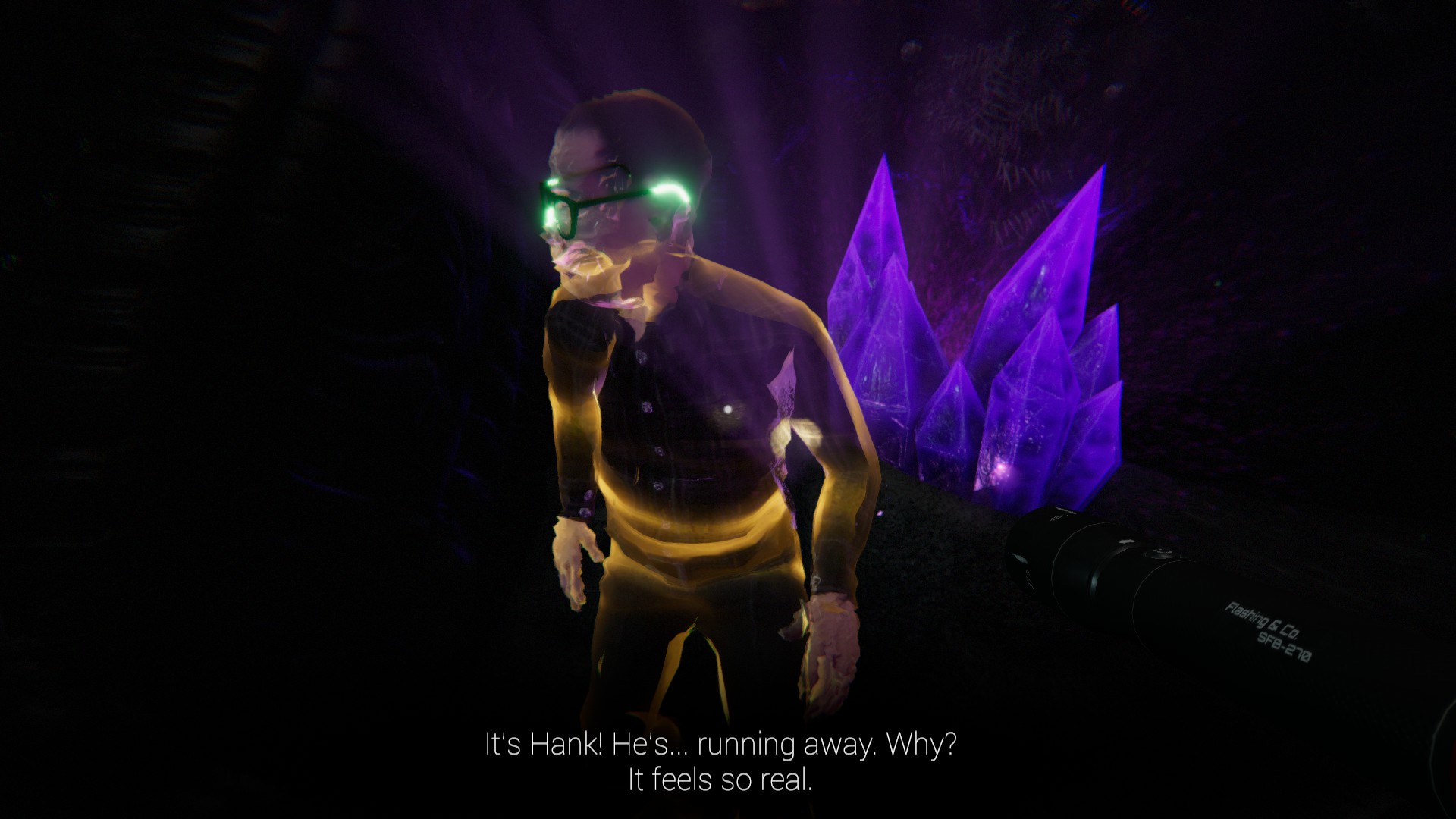
But there’s a wall there!
Johnathan can die. He is exceedingly fragile and will bite the big one in a single hit with alarming frequency. Johnathan can fall normal distances that people could easily survive and then die immediately. He also likes to die in mid-fall. I guess he’s dying from shock? The real problem in Sanity of Morris is, naturally, the enemies consisting of useless soldiers and aliens. Stealth rules are at play here, and they have clear cones of vision. It’s blue if everything’s normal, yellow if they’re suspicious, and red if you’re about to get your shit ruined. If they see Johnathan, he will almost certainly die. But the way this plays out is ridiculous.
Enemy animations are horrid. The humans move strangely and they all carry batons that will incapacitate Johnathan on contact. Aliens, however, mostly don’t have attack animations. Johnathan will simply die after they approach him. Humorously, he can merely touch either of them and then drop dead. The rules for what constitutes a fatal touch are up in the air, as I’ve been killed by an enemy multiple feet away. Other times, I got spotted through walls or died from having an enemy that wasn’t aware of my presence clip through a wall to reach me. Good grief. Sanity of Morris loves to task you with exploration, only to have enemies hang around. And they love to hang around. I spent a lot of time waiting for them to leave an area, as they linger for inordinate amounts of time.
I will say this, though: Sanity of Morris made me laugh. The awful narrative combined with the janky enemies and graphical dodginess on display elicited a fair amount of cackles in between the near-ceaseless derision that comes with playing this game. It takes about five hours to finish and has a binary choice at the end. But all that changes is the last 15 seconds. This is not a good game and I repeatedly regretting playing it. But if you or your friends like to laugh at drivel, this would probably fit the bill nicely.
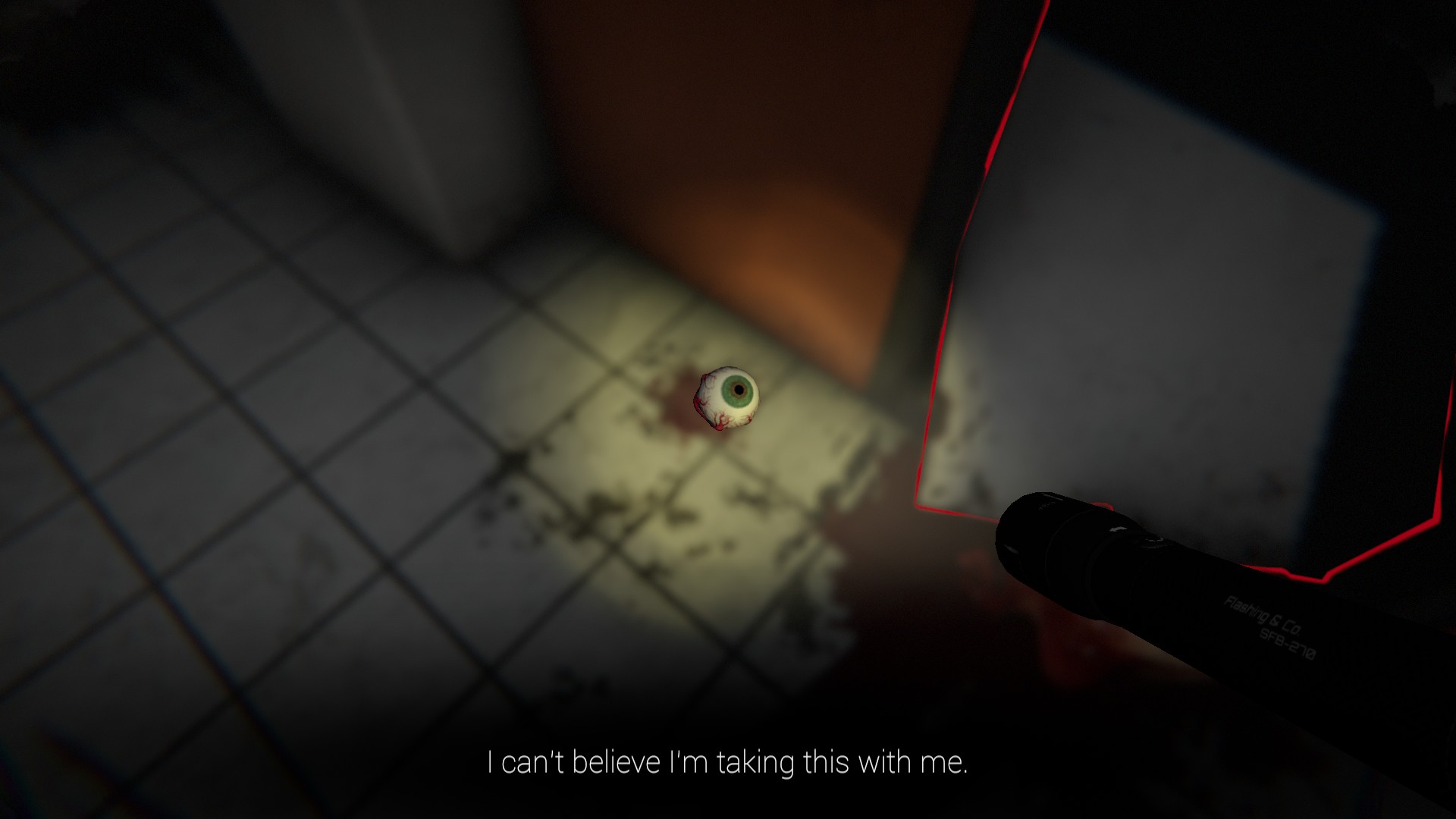
System Requirements.
MINIMUM:
Requires a 64-bit processor and operating system
OS: Windows 7, 8, 10 (32 bit or 64 bit)
Processor: Intel® Core™ i3 or AMD Ryzen™ 3 1200
Memory: 4 GB RAM
Graphics: DX11 supported dedicated graphics card with atleast 2 GB VRAM.
DirectX: Version 11
Storage: 3 GB available space
Sound Card: Onboard or better
-----------------------
RECOMMENDED:
Requires a 64-bit processor and operating system
OS: Windows 7, 8, 10 (32 bit or 64 bit)
Processor: Intel® Core™ i5 or AMD Ryzen™ 5 1500
Memory: 8 GB RAM
Graphics: NVIDIA® GeForce® GTX 1050 (VRAM 2 GB) or AMD Radeon™ RX 560 (VRAM 2 GB)
DirectX: Version 11
Storage: 3 GB available space
Sound Card: Onboard or betterSpoiler-
 1
1
-
-
-

We need members i'll give you the chance, you have to improve ur activity in our channel on ts3.
Welcome to The family ❤️
-
 2
2
-
-
-
Game Informations.
Developers : Gentlymad Studios.Publishers :Assemble Entertainment, WhisperGames.
Released : 18 Mar, 2021.
Genre : Strategy, City Builder, Simulation, Survival.Mode : Single-player.
Platforms : Microsoft Windows.
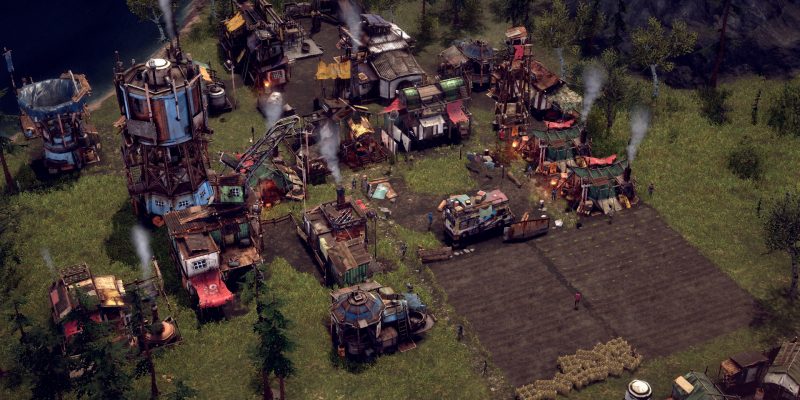
You know what we need? An honest-to-God Mad Max post-apocalyptic city builder, where waterworks are as important as the Fight Pit. However, not all devs think that way, so that’s why we get Endzone: A World Apart, in which rebuilding humanity after the fall takes a more civilized bend.
I bet you’d like to know what an Endzone is. Well, it’s something you won’t deal with too often for a game named after it. An Endzone is an underground bunker housing survivors of the collapse – a Vault, if you will. However, nobody wants to stay cooped up and breathing refiltered farts for too long. The survivors mosey out while the world is still plagued by radioactive rain and devastating sandstorms. As the genre-standard disembodied mayor in the sky, it’s up to you to keep a settlement running despite these natural-ish disasters.
Look, Endzone: A World Apart is a game that takes very much after Frostpunk, but less as a sibling, and more like a less glamorous third cousin. Instead of a marvelous reactor core being the beating heart of your settlement, you’ll have a broken-down camper van as the town center. Now get to building!
Building around your humble beginnings
The poor souls under your command want what any human wants: not to die. To facilitate this desire, you’ll have to put food in their stomachs, quench their thirst, raise a roof over their heads, procure medication to cure what ails them (usually nondescriptivitis), and wrap them in layers of insulation from radiation. It would be superb if you could find the time to collect all the corpses, maybe establish a place for the live ones to gather as well, and probably even build a watering hole where the humble H20 is fortified with a couple more Cs and four additional Hs.

The game posits that settlers wouldn’t reproduce in your shantytowns due to lack of privacy, which goes entirely against what we know about the urge to, ugh, scratch that particular itch.
But what you start with is about a dozen adults, half as many children (who will soon mature into useful adults – Endzone: A World Apart has aging in it), and the broken-down camper van that has some resources to keep you going. Obviously, what you want to do first is slap a jetty down at the nearest lake, build a cistern close by, and then assign some of your citizens to be water carriers. With that out of the way, you might want to start thinking about more sophisticated resource chains.
This is where Endzone: A World Apart dares to break away from the usual milieu in that even the populace that isn’t press-ganged into dirt farming can be used in resource extraction. You can set tasks, designating areas where free hands will be used to gather some type of resource (or all of them, that’s an option). This means that you have some leeway when it comes to early resource crunches. Sure, you might not have the scrap to build a scrapyard right now, or maybe your old one was knocked down by a sandstorm or raiders, but don’t worry! It’s not a death spiral as long as there are scrap piles small enough to be picked through by hand.
Endzone: A World Apart runs on scrap
And believe me, in Endzone: A World Apart, scrap might as well be the spice mélange. It does not allow space travel, nor does it expand consciousness, but it’s useful both as a building material and as a precursor to several others. To be precise, scrap goes into recycler huts to be transformed into either cloth, metal, plastic, or (with some research), electronics.And you absolutely want your recycling up fast, because cloth is used in every sort of protective gear, from the humble cloth mask to activated carbon masks and to radiation suits. Radiation is an ever-present danger and annoyance in Endzone, so personal protection at least keeps your post-apocalyptic pioneers from soaking it up in their spare time.
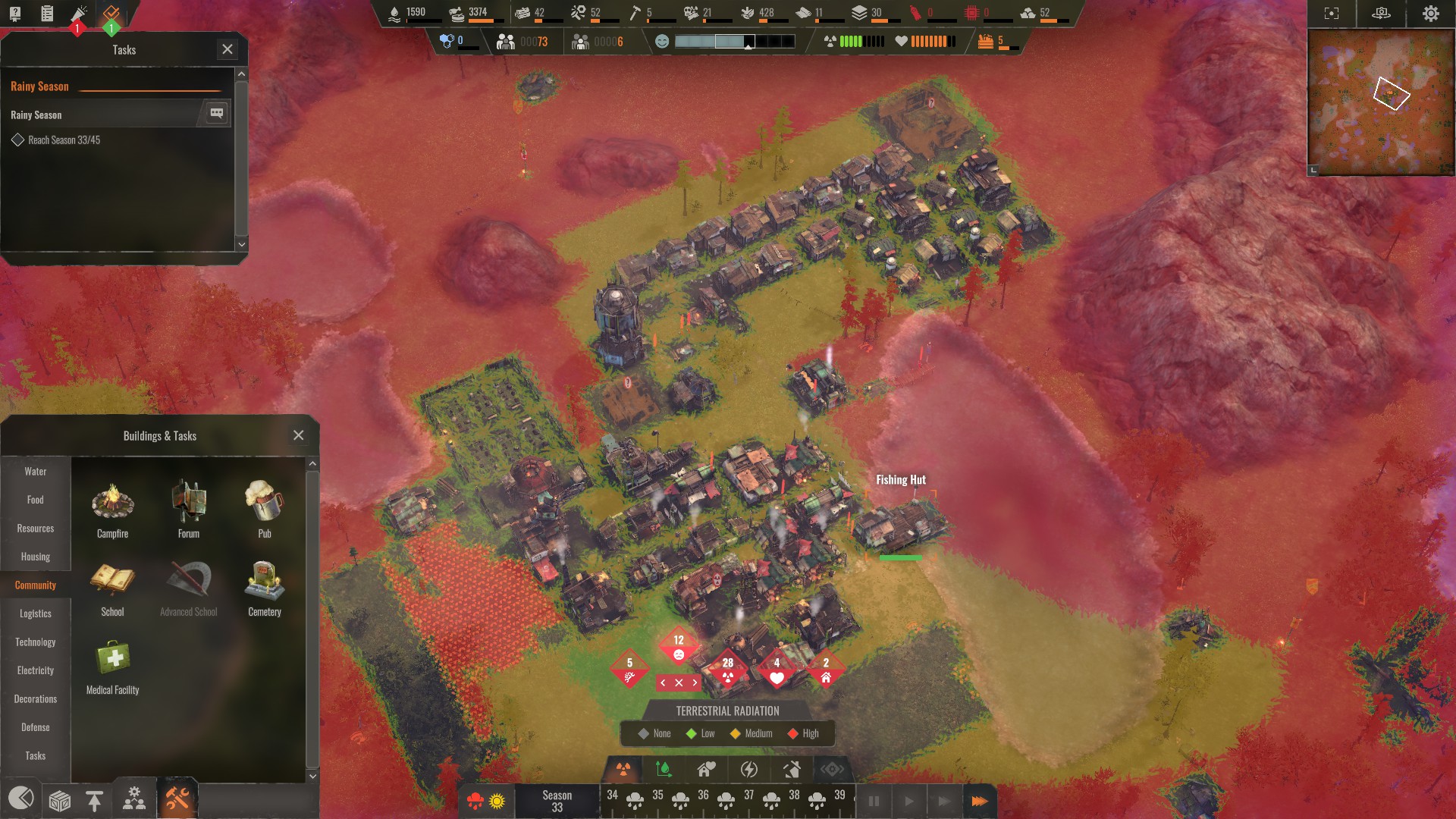
This is what scientific literature describes as “a bad time.”
Luckily for us, the other super important filtration component – charcoal – is a lot easier to obtain. Trees are literally everywhere, your foresters replant trees as trivially as they cut them down, and wood isn’t the source of four different other materials. Charcoal itself is basically used in making protective clothing, decontamination kits (it’s how you make your food stop glowing in the dark), and filters in water towers. It’s a lot less troublesome than other industries, and a lot easier to scale when need be.
Managing both your expectations and turnip production
You may have an occasional hiccup in food and water production, but only the production of the former is in any way involved. Your first meals will all smell of fish, because it’s so easy to plonk down a fisherman’s hut next to the water harvesting jetty, and it starts cranking out produce immediately. But then you have farms and orchards – which rely on water just like fishing, but also take time to grow. They also saddle you with choices of what to grow – different plants take different amounts of time to mature, plus, wheat is useful in making bread of the liquid variety. You also have gatherers that go rooting for shrooms and berries into the woods, and pastures that rely on your hunters to capture animals to keep. Some of those animals can even provide resources other than meat.
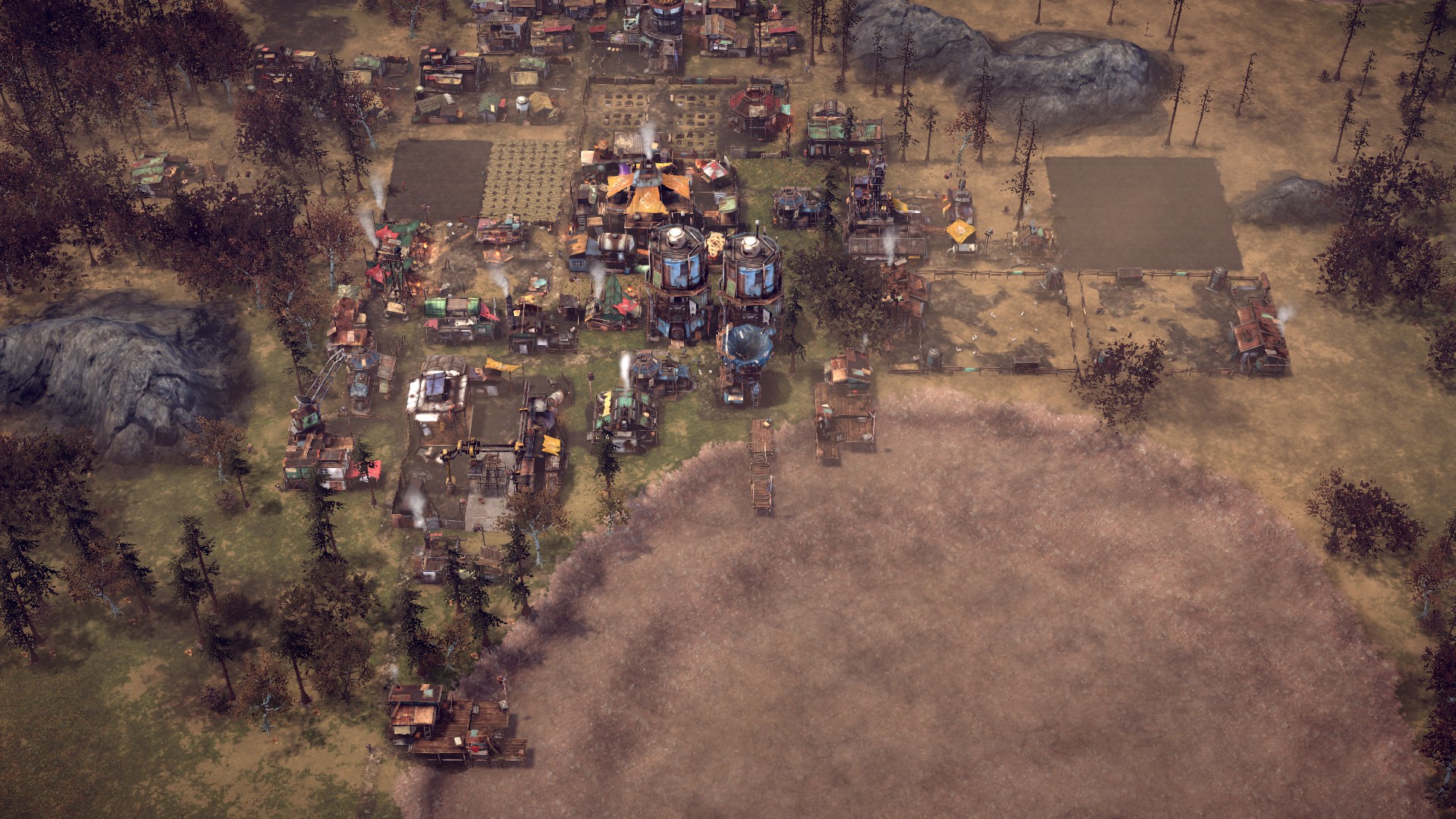
Droughts are an another reoccurring disaster, but they don’t last too long, and you should be OK even without having less water-reliant food sources if you have a decent stockpile.
Oh, and before you try to optimize yourself into a monoculture, Endzone reminds you that citizens need to eat a good variety of food, or else they’ll be struck by an epidemic of nondescriptivitis.
As I mentioned, you have some leeway with your starting build order, but not too much. What’s more, you’re rushed, almost at gunpoint, to generate enough resources to be able to sink them into research. Without doing costly research, you can’t even access certain areas of the game like the weather station, which both predicts how radioactive incoming rains will be and allows you to set food and water production policy according to radioactivity. Do you want to enjoy the wonders of electrification? That’s at least two research techs and a research tier away.
Expeditions: Scrap Vikings
And this is how I transition seamlessly into probably the most interesting aspect of Endzone: A World Apart: expeditions. Once you have an expedition center ready, you can employ people as scouts. These guys will go to interesting ruins (all on the same map as you are) and tell you what’s there. Then you can mount an expedition by collecting a group of citizens to explore it in a more thorough way.
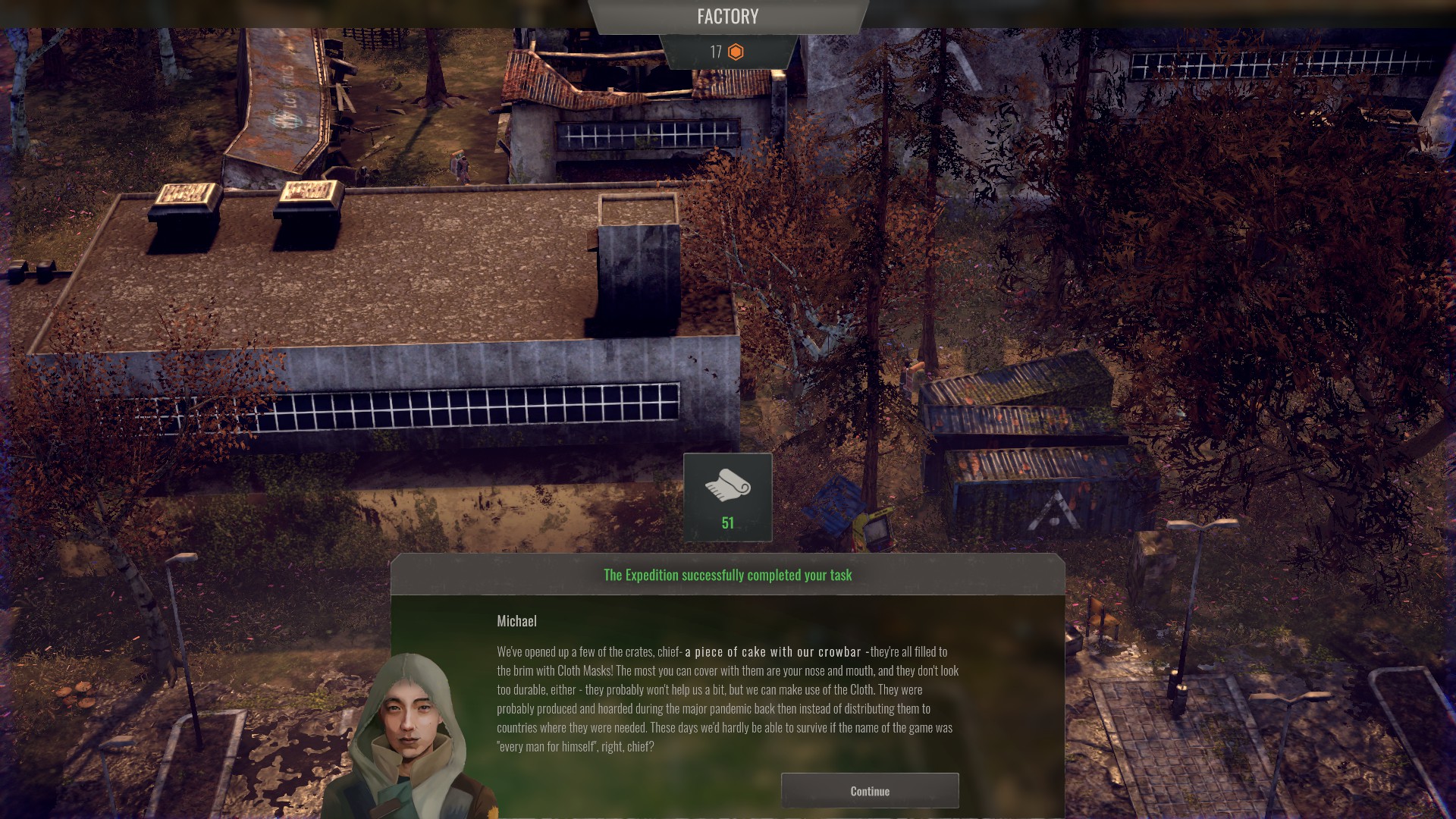
The game delivers topical social commentary with a hand encased in iron.
Expeditions are fun, as they can have many and varied requirements to pull off successfully like “have young people aboard” or “everyone should wear radsuits.” You can ignore these, but then your odds of getting the best result in the short, nearly text adventure-esque quests decreases significantly. Another cool thing is that expeditions aren’t one and done: you can return to collect any loot left behind or to complete challenges you weren’t ready for the first time around.
A bit less exciting of a development are the raider attacks. In Endzone: A World Apart, the post-apocalyptic bandits are nice enough to give you a call before attacking. You even have a choice: pay a tribute, or get rekt. There are several bandit personalities, and they want different things. But failure to pay only ever has one outcome: a band of hoodlums will raid your settlement, stealing resources and knocking down buildings. I hope you’ve researched the ability to defend yourself and place your tower defense-esque fortifications appropriately!
The less exciting aspects of surviving the fall
That’s certainly something I don’t remember seeing in Frostpunk. But you know what I do recall? The political management of the settlement via edicts and the two different paths they can take you. In Endzone: A World Apart, you can declare edicts once you build a forum, but they only last some time and aren’t as dramatically expressed. It’s also a place where you can pick and choose missions for your citizens to accept. Without a forum, you’ll only get missions at plot-related or crisis-mandated points. It’s funny, solving the issue of water shortage and being rewarded with more water. Wonder where they kept that – and why did they not share.
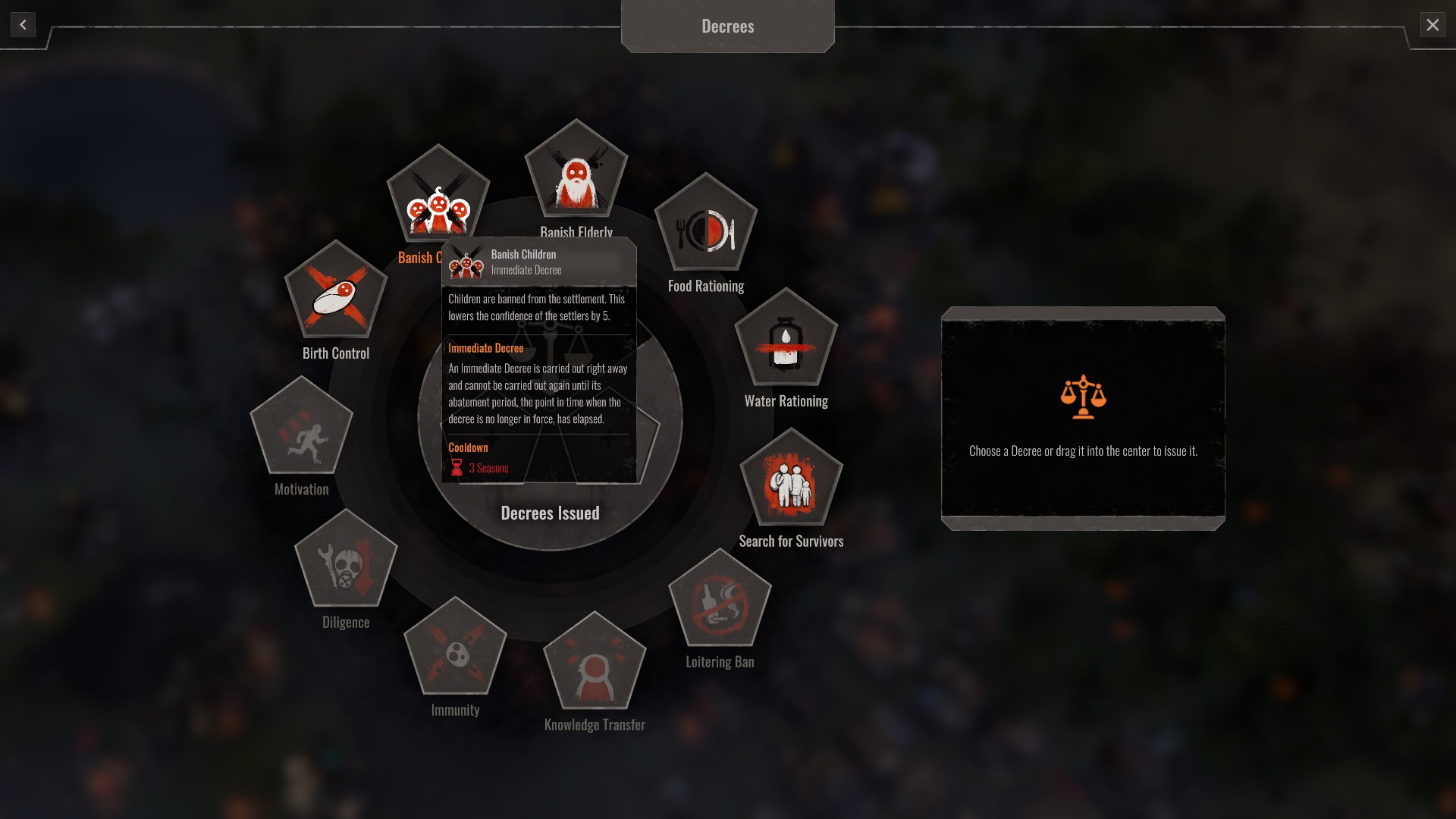
Succumbing to the demands of r/Childfree is delivered with the same dramatic impact as telling your citizens to eat more herbs to stay healthy
Everything I’ve expressed so far will be learned during the tutorial, which is like a fast playthrough of the entire settlement development cycle. It prepares you for the free-form survival mode and scenarios. Scenarios, however, are blatantly meant to test your skill in specific areas, like saving a settlement of incompetent goobers from a crisis of their own making, managing water, or fending off aggressive raids. Too bad none of them have the impact of the first Frostpunk scenario – and you’ll have seen most of the content you can expect during the tutorial.
This sure looks like the end of the world
Wearing towards the more technical side of things, Endzone: A World Apart isn’t the prettiest game out there, but it has its moments. Notably, you can tell the rate of protective gear adoption simply by looking at your population’s portraits. Or when you start issuing rad suits, based on the way they look in the field. Unfortunately, the portraits and the dialogue that often comes with them during the events could both use some work.
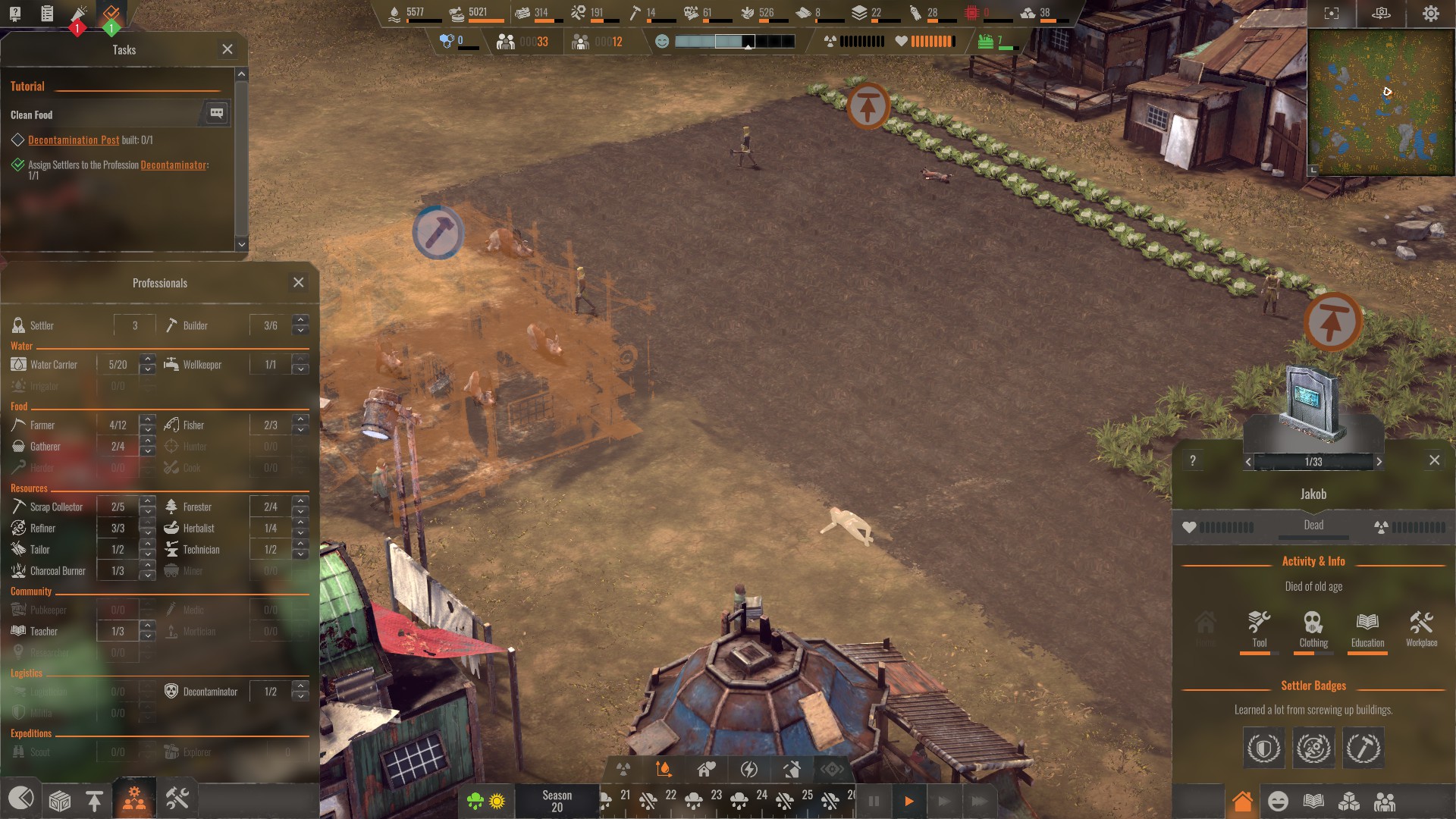
“Here lies Jakub, maker and creator of the devil, swine merchant. His time was finally at hand”
However, in games like Endzone: A World Apart, audio matters more than zoomed-in visuals. Why? Because you don’t have the time or a reason to be zoomed in. None of these games give a compelling reason to run them at speeds other than the fastest one available. When it’s not a crisis situation, stuff develops slowly enough that you can’t be bothered to wait it out in real-time. And when something goes down – well, you have the pause button for a reason.
All in all, Endzone: A World Apart is certainly an interesting game. It has its own charming elements to set it apart from the pack – the expeditions, the protective gear representation – but, it’s certainly lacking in staying power. It’s kind of hard to maintain interest when the tutorial takes you through most of what you can see in the game. Most scenarios also make you start with the boring first step no matter the premise.
System Requirements.
MINIMUM:
Requires a 64-bit processor and operating system
OS: Windows 10 64-Bit
Processor: I5-2500K, 4-Cores @3.30 GHz or equivalent AMD-Hardware
Memory: 8 GB RAM
Graphics: GeForce GTX 760
DirectX: Version 11
Storage: 6 GB available space
Additional Notes: Supported: Monitors with 16:10 and wider aspect ratios (NOTE: 5:4 and 4:3 aspect ratios are not supported)Spoiler -

A suburb of Chicago is to become the first city in the United States to pay reparations to black residents who have suffered housing discrimination.
The city council in Evanston, Illinois, voted 8-1 to distribute $25,000 (£18,000) each to 16 eligible black households to use for home repairs or as down payments on property.
The funds come mostly from a new tax on legalised marijuana.
Black Americans were disadvantaged by racist housing decisions.
To be eligible, residents must be a black person who lived in Evanston between 1919 to 1969, or a descendant of such a person. The family must also have been a victim of discrimination in housing because of policies or practices in the city in that time.
"We're very excited to see the first national direct benefit from some of the harms we've had to experience from the past," Kamm Howard, co-chair of the National Coalition of Blacks for Reparations in America,
"The more local initiatives occur, the more impetus there is on the federal government to act."

But not everyone has been supportive of reparations in this form.
Alderman Cicely Fleming, who is herself black and voted against the plan, said she supported reparations, but said the plan assumed black people could not manage their own money.
"True reparations should respect black people's autonomy and allow them to determine how repair will be managed," she said.
Discussions over how to address housing discrimination increased following a report last year that illustrated how black people had faced restrictions on where they could live dating back to 1855, when the first black resident arrived.
The impact over generations "was cumulative and permanent. They were the means by which legacies were limited and denied", the report stated.
A fair housing law was passed in Evanston in 1968, but evidence showed that black people were steered towards a section of town where they were the majority until 1985.
Hundreds of communities across the US are considering reparations to black people, including the state of California, Iowa City and Providence, Rhode Island.
But there is not a lot of support for such reparations in the US.
A Reuters/Ipsos survey last year found that just 20% of respondents backed using "taxpayer money to pay damages to descendants of enslaved people in the United States".
The movement towards some form of reparation for African Americans as a restitution for centuries of slavery and racism accelerated in the wake of the death of George Floyd last year. The unarmed black man died in Minneapolis while detained by police and this sparked worldwide protests.
-
-
Hello, first you have to join in our projects and make activity on it + help in development the projects.
Here our Projects, you can apply : https://csblackdevil.com/forums/forum/14654-staff-projects-apply/.
You can return with a new request when you ready with perfect activity and part of our projects .

-
 1
1
-
-
-
Spoiler
-
DH1, i like it more than DH2.
-
DH2, love that song, more batter than DH1.
-
Game Informations.
Developers : Beard Envy.Publishers : Kasedo Games, Maple Whispering Limited.
Released : 23 Apr, 2020.
Genre : Puzzle, Action.Mode : Single-player.
Platforms : Microsoft Windows - Linux - Nintendo Switch.
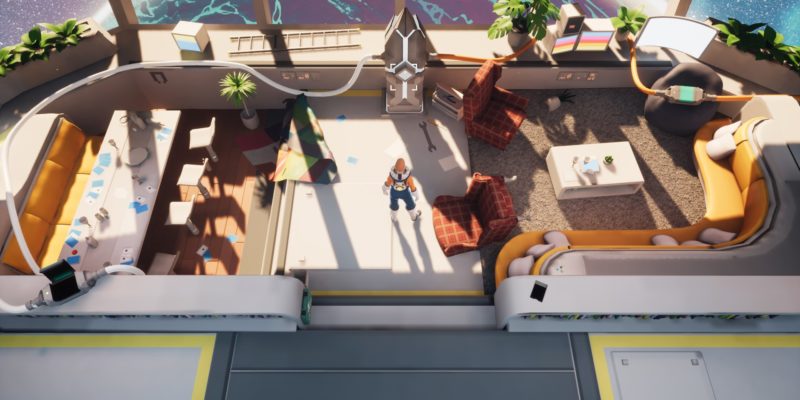
he derelict Alabaster floats comfortably at the edge of space where it waits for its first challenger. Your space-faring hero, dubbed Pluto by the ship’s imprisoned navigator, answers that call. Pluto’s knack for exploration is rivaled only by his otherworldly patience, and hopefully, you’re the same. I’m not. Hacking your way through a space cruiser isn’t rocket science — it’s much harder. Filament is no relaxing getaway; the Alabaster’s deceptively cozy halls are home to hundreds of head-scratching puzzles.
Welcome home, captain
You’ll find your stay on the Alabaster to be equal parts comforting and ominous. Despite being hastily abandoned for reasons unknown, the ship retains its homey atmosphere. Its rich color palette and lived-in look are complemented by an encouraging soundtrack with a melancholic streak. As you traverse its many rooms, the ship’s navigator, Juniper, spins you tales about what once was. It’s in unraveling the mysteries left behind the crew that I found a reason to keep at those pesky puzzles.

Explore some floors.
Juniper’s commentary is directly tied to a number of machines, called Anchors, which you can hack. Punctuating the ship are dozens upon dozens of these Anchors, each housing a set of five puzzles. Only by completing the entire set can new rooms, lore, and challenges be revealed. Filament’s puzzles threw me for a loop when we previewed the game, and they’ve only gotten tougher and more diverse.
Hacking the mainframe
Upon interacting with an Anchor, you’re transported into a closed room, now in control of a cute, tiny robot leading around a glowing cord. You must lead this infinitely extendable cord around the room, ensuring it touches every energy cell to power the exit gate. Wrap around the proper pillars and weasel through spaces in the correct order to advance. Much like a maze, the goal is to arrive at the golden route that leads to the finish. But, like a game of Snake, your robot can’t pass through the taut cord it leaves behind.
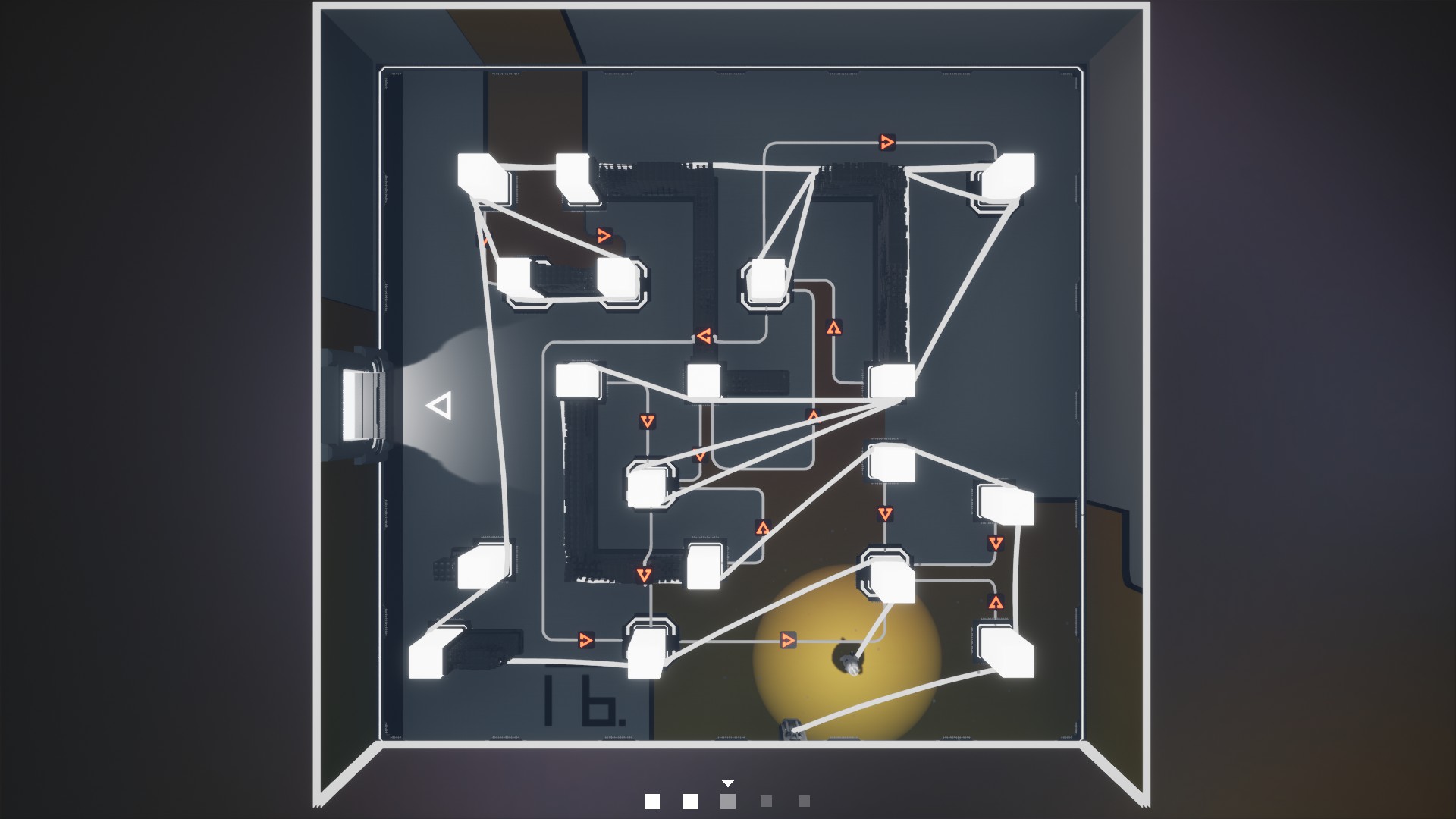
Things are happening, but I don’t know what.
The challenge ramps up rapidly, with more and more obstacles to overcome with each passing puzzle. And with puzzles coming in sets of five, you can expect to spend ludicrous amounts of time at each Anchor. As you work your way up the Alabaster’s floors and through its myriad wings, new flavors of puzzles are introduced in the form of additional mechanics. Floor panels, color matching, and multiple robots are only some of Filament’s sick twists. However, we should be thankful; with each new mechanic comes an easy tutorial Anchor to sooth our player egos.
Tried-and-true trial and error proves to be the method of choice for tackling these puzzles. With so many steps in each solution and so many moving parts, planning ahead only gets you so far. Filament’s puzzles are abhorrently difficult to parse. Puzzle structure alludes to certain solutions, but the complexity invites cognitive overload. Keeping track of my potential moves and their order, especially in color-oriented puzzles, was ungodly frustrating. The game expects you to keep iterating on your solutions, but it lacks much-needed footholds to help you manage them.
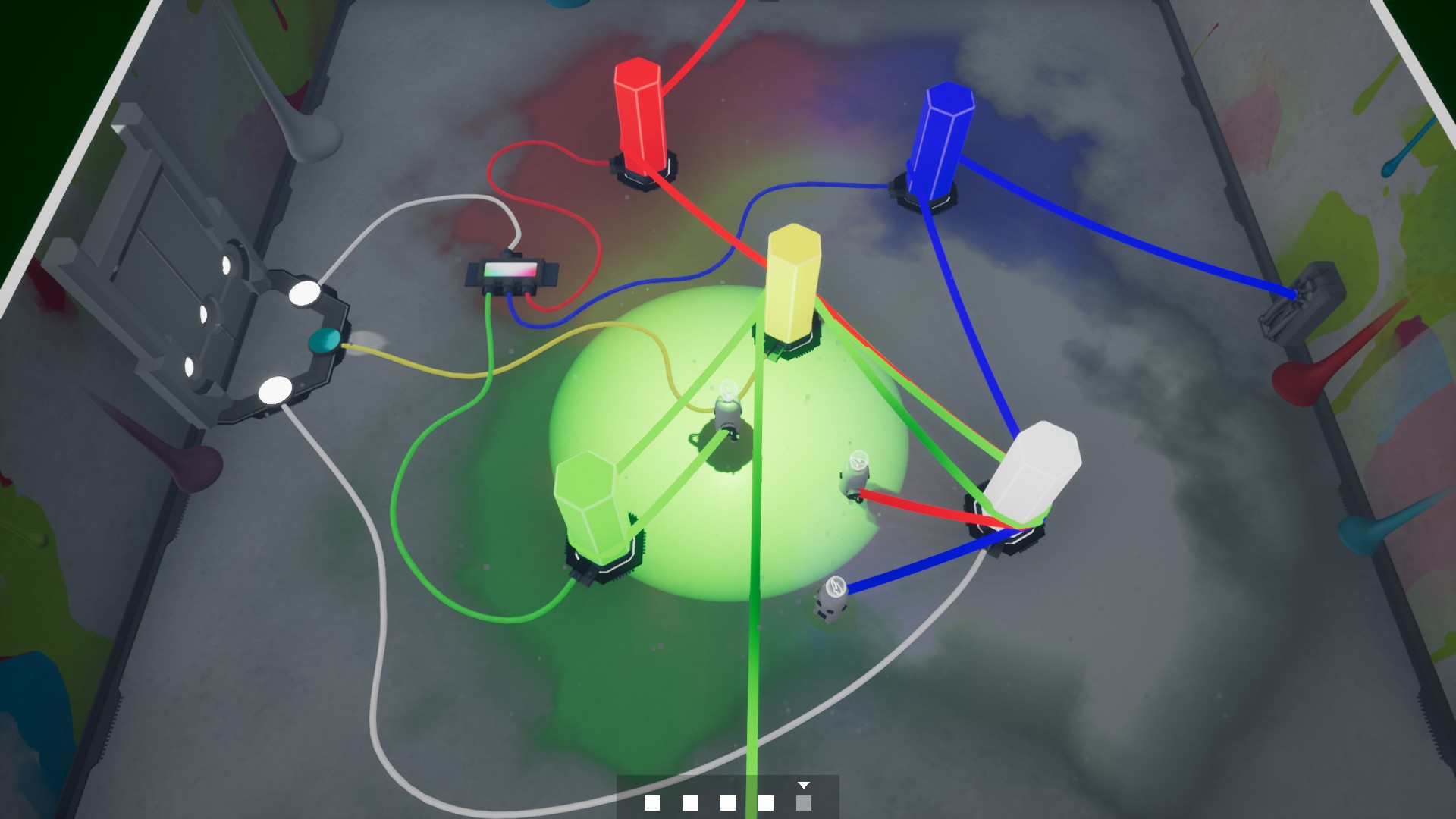
Puzzles, permutations, pain
Slow and steady wins the space race
Fortunately, Filament is not linear; nothing stops you from trying your hand at a different Anchor if one has you stumped. I spent most of my time bouncing between Anchors, subjecting my little robot to all manner of torture in hopes of a breakthrough. I wanted so desperately to know the Alabaster’s secrets, but five puzzles per Anchor wreaked havoc on the game’s pacing. Perhaps I’m an outlier, and you’ll have a far easier time with the puzzles. Yet, with a few hundred puzzles to work through, everyone should expect a huge helping of challenge.
Every completed Anchor prompts new commentary from Juniper and often yields a code that can be entered into nearby computers for additional lore. Initially enticing, these tiny nuggets of story were no longer satisfying rewards for my herculean endeavors. If only puzzles came in smaller sets, split amongst a larger number of Anchors. Of course, a larger ship with more stories to tell would be needed to accommodate — a greedy ask. Clearing any less than five puzzles at an Anchor nets you absolutely nothing; for many, it’s a killing blow to their motivation levels. But I know a great number of masochists who need no other reward than the challenge itself, and those players have my respect and a new game recommendation.
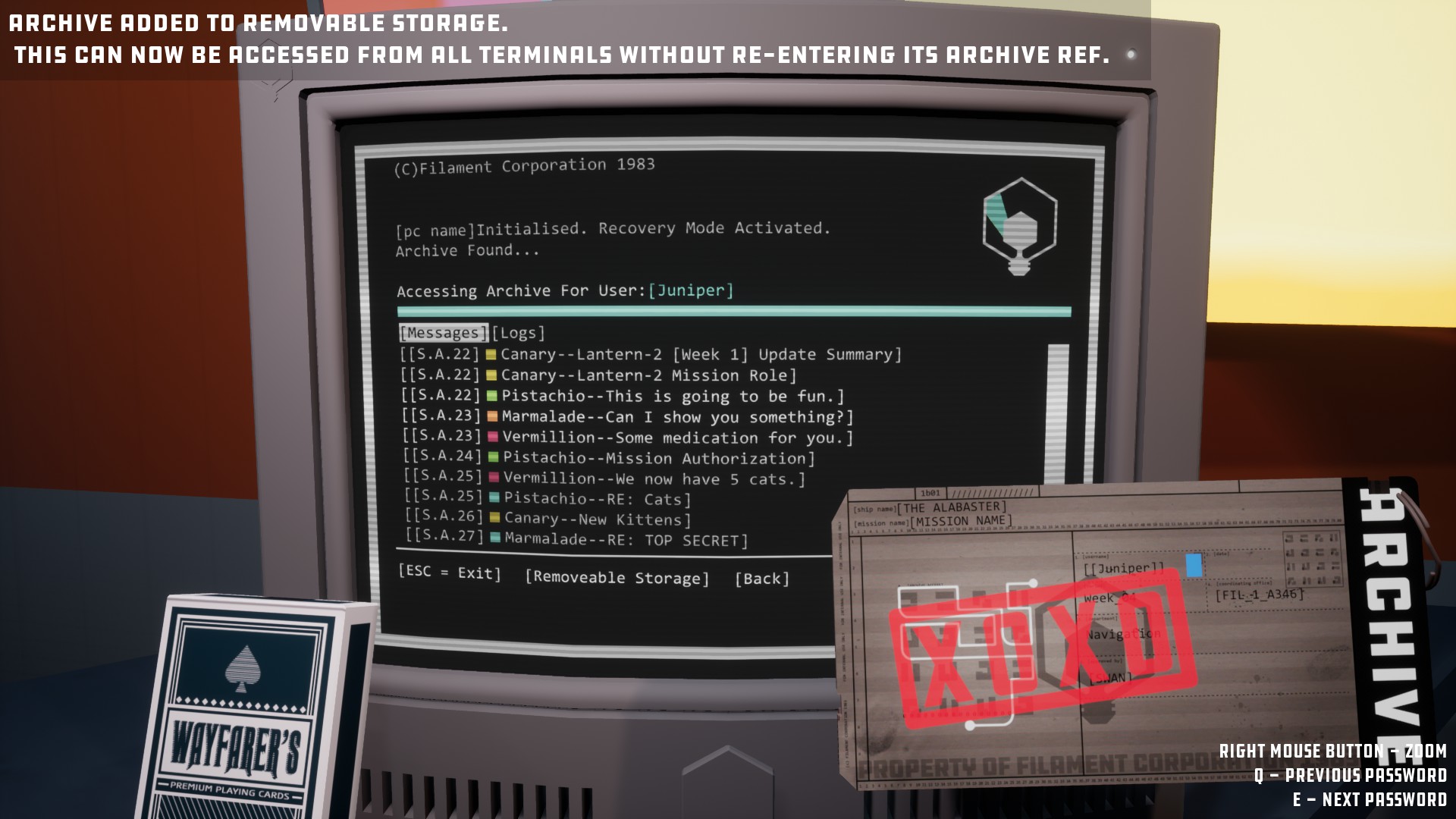
Time for a lore break
Connection lost
Filament presents both challenging puzzles to solve and an intriguing world to explore, but there’s far too much on one thing on the plate and not nearly enough of the other. Its means of puzzle delivery fails to provide a sense of presence. My interests lie in the Alabaster, but most of my time is spent locked up in a tiny room with a tiny robot. It’s hard not to draw comparisons between Filament and The Witness, which developer Beard Envy undoubtedly drew heavy inspiration from.
The Witness placed heavy emphasis on incorporating the environment into its puzzles and promoted lateral thinking, which only served to strengthen your connection with the game world. At times, it’s as if Filament aims to accomplish the exact opposite. I found myself bouncing back and forth between two very different experiences: Juniper’s relaxing ship tour and cold, crushing puzzle gauntlets. Mechanics aside, puzzle rooms do evolve to incorporate more visual stimuli, but their largely drab looks stand in stark contrast to the Alabaster’s lush visuals.
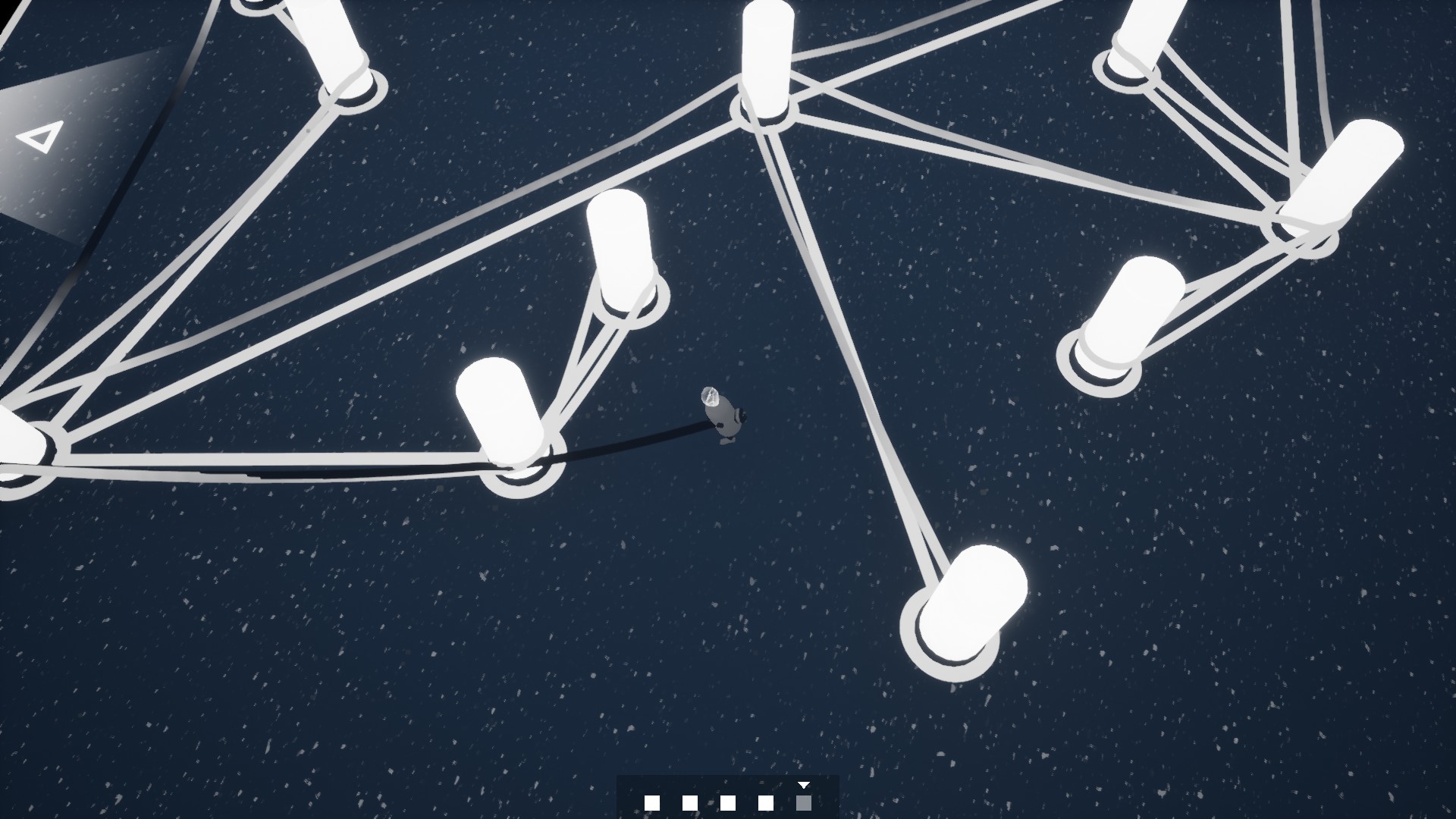
Puzzle time, all the time
Everything’s looking shipshape
The nature of the core gameplay loop doesn’t lend itself to long play sessions; Filament is best in moderation. Its puzzles are clever, but they become difficult to appreciate when presented in such large quantities. An Anchor a day keeps the fatigue away. Clearly speed is not something the Alabaster’s puzzles value. I only wish Juniper had more to say — her commentary is a constant reminder of my goals on the ship.Filament’s environments and competent puzzles are enjoyable in isolation. Story-oriented players will find a lot to love about the Alabaster and Juniper’s lyrical efforts to drown its rooms in emotion. Puzzle fanatics will appreciate the endless deluge of complex hacking and its variety. It’s the melding of the two where Filament struggles to find its footing. Lengthy bouts of disparate puzzle-solving take away from the storytelling, while the Alabaster has only crumbs to offer as rewards for your efforts.
System requirements:
MINIMUM:
Requires a 64-bit processor and operating system
OS: 64-bit Windows 7, 64-bit Windows 8 (8.1) or 64-bit Windows 10
Processor: Quad Core
Memory: 4 GB RAM
Graphics: 1GB AMD Radeon HD 6870, 1GB NVIDIA GeForce GTX 745 or better
Storage: 1 GB available space
Additional Notes: Requires a 64bit Processor and Operating System------------------------
RECOMMENDED:
Requires a 64-bit processor and operating system
OS: 64-bit Windows 7, 64-bit Windows 8 (8.1) or 64-bit Windows 10
Processor: Quad Core
Memory: 8 GB RAM
Graphics: 2GB AMD Radeon R9 280, 2GB NVIDIA GeForce GTX 950 or better
Storage: 1 GB available space
Additional Notes: Requires a 64bit Processor and Operating System
Spoiler -
-
 1
1
-
-
DH1
DH2
-
 4
4
-
-
Spoiler
Battle Cancelled
-
 3
3
-
-
Game Informations.
Developers : Online R&D.Publishers : SEGA.
Released : 5 Aug, 2020.
Genre : Action, role-playing, Massively Multiplayer Online.Mode : Single-player, Multiplayer.
Platforms : Microsoft Windows - PlayStation 4 - Xbox One - Xbox Series X/S - Nintendo Switch.
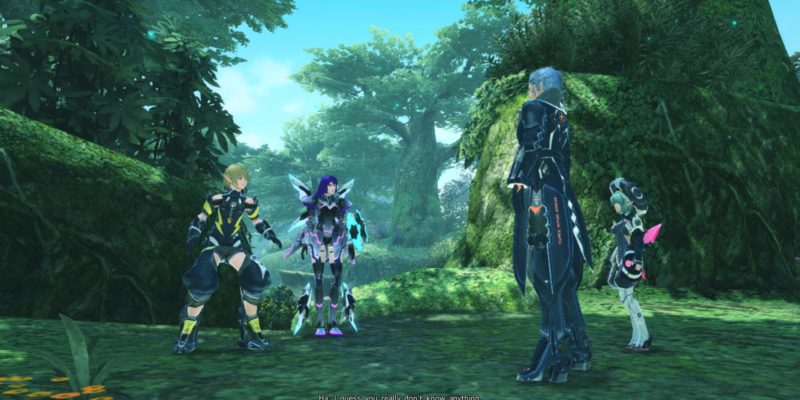
I can’t believe it took nearly eight years for Phantasy Star Online 2 to get an official Western release, but here we are. I dumped hundreds of hours into the game years ago on the Japanese servers, and while I was very taken with it then, time has been less than kind to it. Once you add in the new problems included due to the Microsoft Store, you’re left with a worse version of a dated game that’s nearly half a decade behind the easily playable Japanese version.
Darken my door
The basic premise of Phantasy Star Online 2 is that you’re a fresh recruit in the ARKS organization, which is fighting off an invasion by the Falspawn (unfortunately known as Darkers in the original Japanese). The North American version currently has the first three episodes of the story available, with episodes four and five supposedly coming at a later date. For reference, episode 4 debuted in 2015. I guess they thought it’d be okay to give people time to catch up.While the story used to be unlocked by completing obnoxious objectives in the field to unlock squares on what was known as the Matter Board, now all you have to do is select story quests from the menu. These are made up of cutscenes and levels to play through that advance the narrative, that is — if you even want to do the story. It gives you some useful gear, but it’s also boring, and punctuated by stiff, awkward cutscenes and poor character animation.
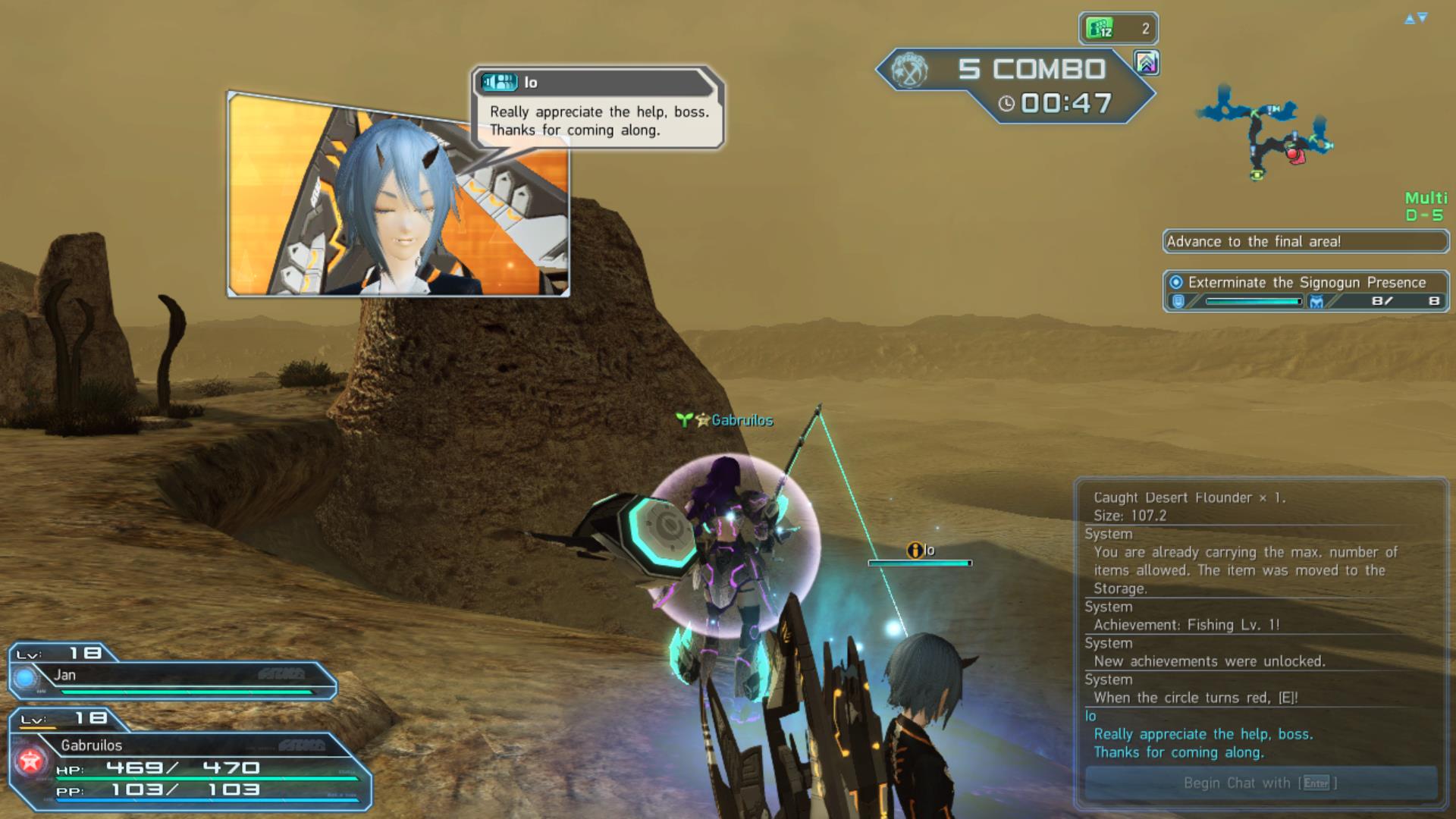
That also applies to the game’s visuals as a whole. Phantasy Star Online 2 wasn’t exactly a great-looking game when it originally launched in 2012, and it looks downright archaic now. Character models are basic and doll-like, and the environments feel small and lifeless. The available anti-aliasing is FXAA, so the game can often look truly terrible. While most enduring online games get some sort of makeover to keep things fresh, this one didn’t. I tried to enhance the visuals with the Radeon Software, but it can’t detect the game due to its being a Microsoft Store app. I had to put Reshade on it to make it look bearable.
Gotta level ’em all
The general structure of Phantasy Star Online 2 is questionable at best. Barring the story, early progression is based around going into exploration fields for each zone and completing them to unlock access to the next ones. These are made up of two randomly generated areas followed by a boss encounter. You can choose to rush through to the boss battle to get it over with, but there are random events to find where you’ll interact with NPCs, fight waves of enemies, or even fight boss monsters.It doesn’t take long for the game to feel like a bit of a pointless grind, but the combat is still as fun as ever. There’s a wide variety of classes and they generally feel quite different from each other. Some classes focus on using melee weapons to smack your foes around, while others give you ranged weapons. My favorite class, Braver, mixes the two by giving you a katana and a bow. The weapons are fun to use and the combat is more fluid and technically proficient than tends to be the case in these sorts of games.
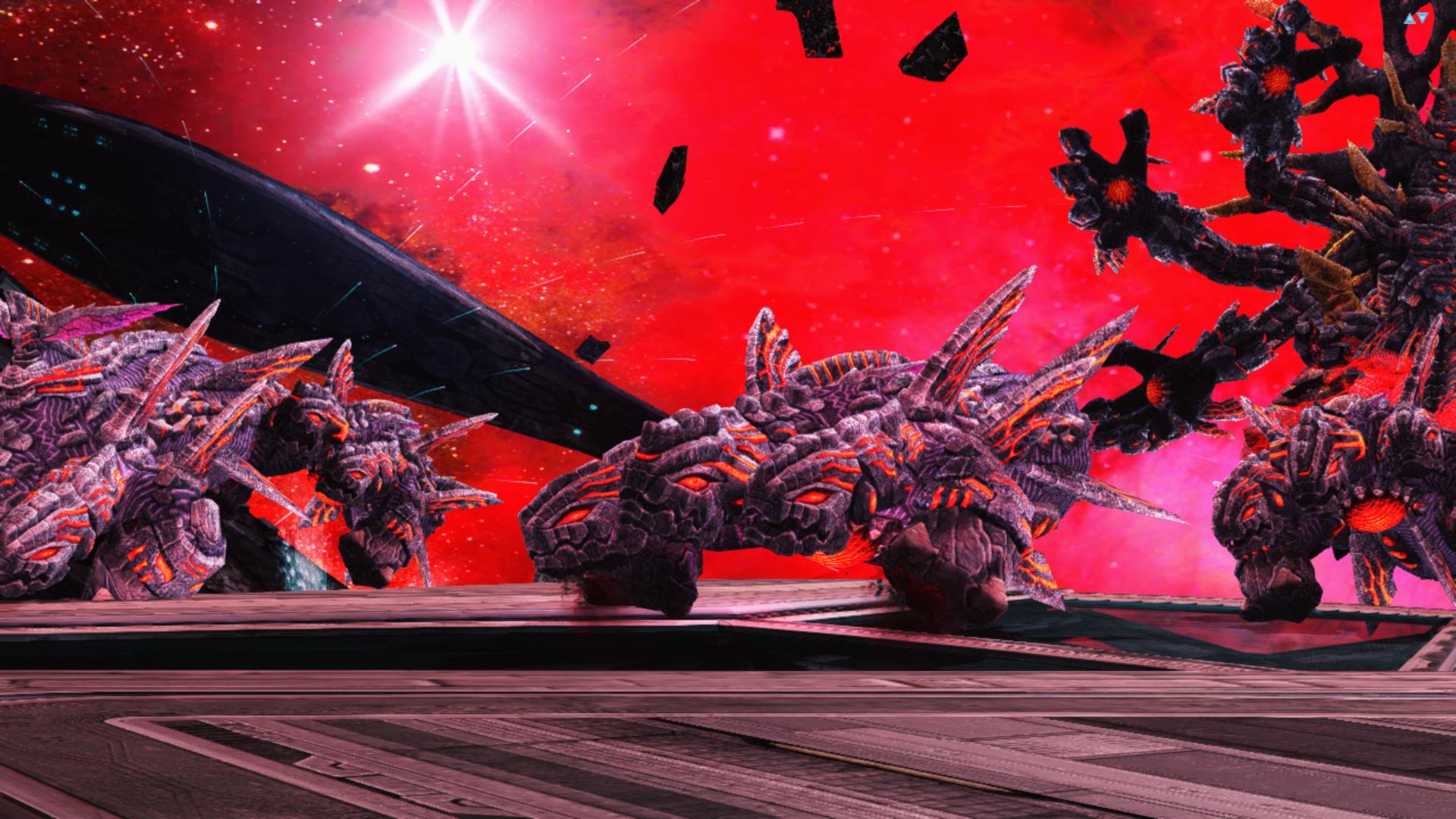
You don’t just wail on things, either. You can dodge, parry, utilize perfectly timed strikes to do more damage, and make use of a large host of Photon Arts. Photon Arts are dropped by foes and can be learned by selecting them in the menu. Then you just open up your subpalette and put them in, and you can use them in battle. Leveling up naturally nets you skill points that you can use to put into skill trees that build up your character. One neat thing that Phantasy Star Online 2 does is that it also has subclass versions of the main classes, which allows players to build their characters in more specific ways while simultaneously leveling a second class.
This is the end, friend
But what would an online game like this be without a solid endgame? Well, funny story, but Phantasy Star Online 2 doesn’t have one. The only real goals that will pop up are new weapons that come tied to events where you have to beat a certain urgent quest. You’ll do this so the boss will drop items that can be used to exchange for better weapons. But that’s only helpful if you want to turn the difficulty levels up as high as they go. The game’s urgent quests are fun, though.Every day has multiple scheduled urgent quests. When it’s time, you just walk up to the quest counter and accept one. These can net you better gear, but once you get to a certain point you’re only going to get a bunch of crap you don’t want that’s just used to improve the weapon you’re currently using. Upgrading weapons is one of the game’s biggest grinds as paying for the upgrades gets very expensive at higher levels. But if you get pulled into the game, you’ll get around this by joining an alliance that runs time trial quests every week to keep you flush with cash.

Speaking of cash, Phantasy Star Online 2 is free to play, and this is one of those games where there isn’t any pressing need to spend any money. That being said, your inventory capacity is capped at 50 slots by default, which is extremely small and you’ll need to buy inventory expansions with ARKS Cash to make it larger. ARKS Cash is also used to buy scratch tickets that can net you new outfits from specific series. As this version of the game has only been around since March, however, the outfit selection is low and the prices to buy some of them with in-game currency on the player marketplace are ridiculous.
Not here to stay
Other than all of that, the biggest objective in Phantasy Star Online 2 is to level up all of the classes. Each time one hits level 75, your character gets a permanent bonus. I still enjoy the combat and have fond memories with the game, but it’s fairly hard to recommend to new players in 2020. Although I jumped back in for a dozen hours or so to get the lay of the land, I don’t feel compelled to get lost in this game again.And even if I did, I’d play the Japanese version, as this one still has some kinks that need to be worked out. Many people can’t even play the game, and those that can get hit by a bunch of giant issues. For one, there’s a ton of lag on the ship. Players found a workaround already, but the professionals apparently couldn’t be bothered to fix it themselves, despite its apparently being simple. I also had an issue where the game wouldn’t let me accept quests due to a glitch during matchmaking.
Most people who were curious about Phantasy Star Online 2 tried it years ago. And players who have stuck with it since can’t move their characters to the new servers and would find less content even if they did, so it seems like a case of too little, too late for the game. At any rate, it was still cool to play the game with everything being in English for once.
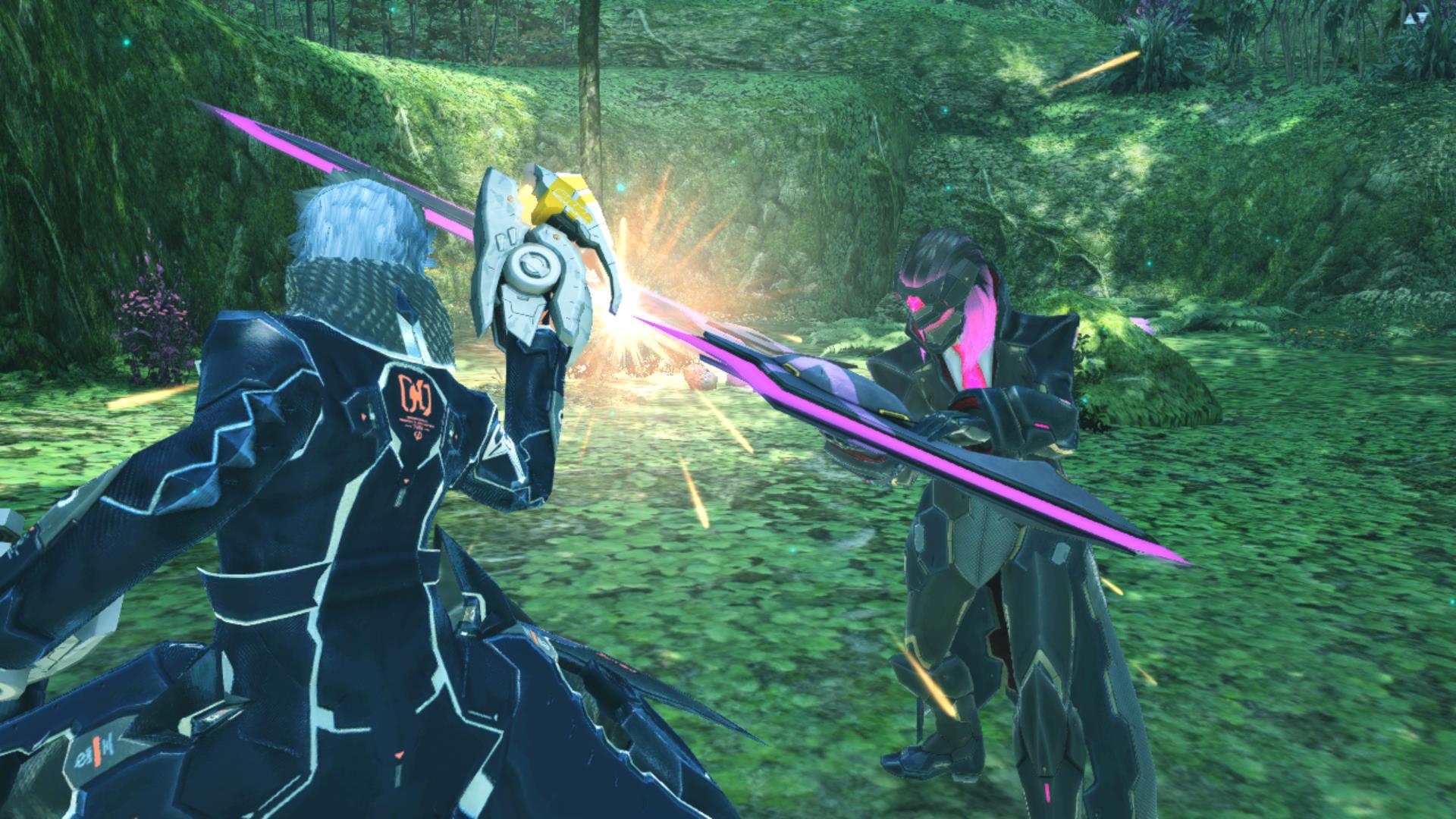
System requirements:
MINIMUM:
Requires a 64-bit processor and operating system
OS: Windows 10 64bit
Processor: Intel Core 2 Duo E6300 and above
Memory: 2 GB RAM
Graphics: NVIDIA GeForce 7800GT AMD RADEON HD2900XT or a Graphics Card of the same caliber and above
DirectX: Version 9.0c
Network: Broadband Internet connection
Storage: 80 GB available space
Sound Card: DirectX Compatible Soundcard (DirectX 9.0c and above)
Additional Notes: Monitor Resolution: 1280 × 720 and above------------------------
RECOMMENDED:
Requires a 64-bit processor and operating system
OS: Windows 10 64bit
Processor: Intel Core i5 6500 and above
Memory: 2 GB RAM
Graphics: NVIDIA GeForce GTX 750 Ti or a Graphics Card of the same caliber and above
DirectX: Version 9.0c
Network: Broadband Internet connection
Storage: 80 GB available space
Sound Card: DirectX Compatible Soundcard (DirectX 9.0c and above)
Additional Notes: Monitor Resolution: 1280 × 720 and aboveSpoiler-
 2
2
-
-
Spoiler
The Winner is @Dark-ImmoRtal^ DH1, with 6 votes against 1.
Congratulations
-
 3
3
-



[Battle] Roselina vs HiTLeR[W Hitler]
in Battles 1v1
Posted
Both are Good, but i'll vote for DH2, Sound, rhythm, lyrics.